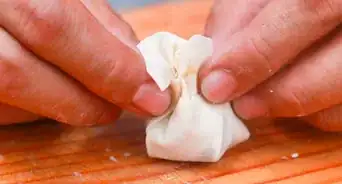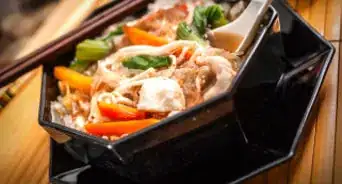This article was co-authored by wikiHow Staff. Our trained team of editors and researchers validate articles for accuracy and comprehensiveness. wikiHow's Content Management Team carefully monitors the work from our editorial staff to ensure that each article is backed by trusted research and meets our high quality standards.
The wikiHow Video Team also followed the article's instructions and verified that they work.
This article has been viewed 127,674 times.
Learn more...
Lo mein is a popular takeout dish at many Chinese restaurants. But if you're a fan of this tasty noodle dish, you can easily recreate it at home and customize it to suit your tastes. The basic lo mein recipe is a vegetable-based dish, but once you master it, you can add chicken, beef, or pork for an even heartier dish.
Ingredients
- 4-5 quarts (3.8 to 4.7 l) water
- 1-2 tablespoons (17-34 g) salt
- 1 pound (450 g) fresh lo mein noodles
- 1 tablespoon (15 ml) dark soy sauce
- 2 tablespoons (30 ml) light soy sauce
- 1 teaspoon (5 ml) sesame oil
- 1 teaspoon (4 g) sugar plus 1 teaspoon (5 ml) hot water to dissolve the sugar
- Pinch of five spice powder (optional)
- 1 tablespoon (15 ml) neutral oil, such as vegetable or canola
- 1 clove garlic, minced
- 1 cup (115 g) sliced mushrooms, such as shiitakes, button, or any type you like
- 1 scallion, cut into 2-inch (5 cm) lengths
- 1 red, orange, or yellow bell pepper, julienned
- 1 small carrot, julienned
- 1 tablespoon (15 ml) shaoxing wine or other rice wine
- A handful of snow peas, trimmed
- A handful of leafy greens, such as bok choy or choy sum
Steps
Cooking the Noodles
-
1Boil water in a pot. Place a large pot on the stove, and add 4 to 5 quarts (3.8 to 4.7 l) of water. To season the noodles, you should also stir in 1 to 2 tablespoons (17-34 g) of salt. Next, turn the heat to high and bring the pot to a boil.[1]
- Don’t add oil to the water. While it can help keep the noodles from sticking together, it can also make them too greasy to allow the sauce to stick to them.
-
2Add the noodles and cook until al dente. When the water reaches a boil, add 1 pound (450 g) of fresh lo mein noodles and allow them to cook until they are soft but still slightly firm. While you should consult the package instructions for cooking times, it typically takes about 3 minutes.[2]
- If you can’t find fresh lo mein noodles at your grocery store, you can use Asian style egg noodles or even thin spaghetti in their place.
Advertisement -
3Drain the noodles and rinse in cold water. Once the noodles are finished cooking, dump them into a colander in the sink to drain away the boiling water. Next, run the noodles under cold water to chill them slightly. Shake the colander well to ensure that they’re fully drained, and set aside.[3]
Preparing the Sauce and Vegetables
-
1Combine the soy sauces, sesame oil, dissolved sugar, and five spice powder. In a small bowl, mix together 1 tablespoon (15 ml) of dark soy sauce, 2 tablespoons (30 ml) of light soy sauce, 1 teaspoon (5 ml) of sesame oil, 1 teaspoon (4 g) of sugar that’s been dissolved in 1 teaspoon (5 ml) hot water, and a pinch of five spice powder if you like the flavor. Stir until all of the ingredients are well blended, and then set aside.[4]
- Depending on the flavors you like, you can also incorporate 1 tablespoon (15 ml) of oyster sauce, 1 tablespoon (15 ml) of hoisin sauce, and/or 1 tablespoon (15 ml) of sriracha sauce into the lo mein sauce.
-
2Heat a neutral oil in a wok. In a large wok or skillet, place 1 tablespoon (15 ml) of a neutral oil, such as canola or vegetable oil. Heat the pan on high for 1 to 2 minutes so that the oil is hot when you add the other ingredients.[5]
- You can usually tell that the oil is hot enough when it starts to shimmer in the pan.[6]
-
3Add the garlic, mushrooms, and the scallions and stir fry. When the oil is heated, mix 1 clove of garlic that’s been minced; 1 cup (115 g) sliced mushrooms, such as shiitakes, button, or your favorite type; and the white parts from 1 scallion that’s been cut in 2-inch (5 cm) lengths. Stir fry the mixture for approximately 30 seconds.[7]
- If you like ginger, you may also want to mix 1 teaspoon (5 g) of minced or grated fresh ginger into the pan with the garlic, mushrooms, and scallions.[8]
-
4Mix the peppers and carrots into the stir fry. After you’ve briefly stir fried the garlic, mushrooms, and scallions, add 1 red, orange, or yellow bell pepper that’s been julienned and 1 small carrot that’s been julienned to the pan. Allow the mixture to stir fry for another 30 seconds to 1 minute.[9]
- Make sure to keep the heat turned to high so the pan stays as hot as possible.
- You can add any of your favorite vegetables to the lo mein. Bean sprouts, bamboo shoots, baby corn, and napa cabbage are other options that you may want to consider.
-
5Drizzle in the shaoxing wine and stir fry for another minute. After you’ve stir fried the vegetables, slowly drizzle in 1 tablespoon (15 ml) of shaoxing wine or another rice wine and combine with the other ingredients. Let the mixture stir fry for another minute.[10]
- You should always be careful when adding alcohol to a hot pan because it’s highly flammable. Measure the wine beforehand and place it in a glass or bowl so you don’t have to pour directly from the bottle.
Pulling the Dish Together
-
1Stir in the snow peas and leafy greens and cook until the greens wilt. Once the wine is incorporated, mix a handful of snow peas that have been trimmed and a handful of leafy greens, such as bok choy or choy sum, into the pan. Stir fry the mixture on high heat until the greens begin to wilt, which should take one or two minutes.[11]
-
2Add the noodles to the pan. After you’ve cooked the snow peas and greens with the mixture, stir in the cooked noodles. Use tongs or chopsticks to move them through the pan, so they’re not all stuck together in a clump.[12]
- The noodles can sometimes get stuck together when they sit in the bowl after cooking. To ensure that they’re loose when you add them to the pan, you may want to rinse them with warm water to break up any clumps.
- If you want to make a hearty meal of the lo mein, consider mixing in some type of cooked meat. Beef, chicken, pork, and shrimp are all delicious additions to vegetable lo mein.
-
3Pour the sauce mixture over the noodles and stir fry for several minutes. Once the noodles are incorporated, add the sauce mixture that you created to the pan. Stir fry all of the ingredients until the noodles are well coated in the sauce and a uniform color.[13]
- The best way to ensure that the noodles are well coated with the sauce is to use a folding motion as you stir fry. Scoop and lift the ingredients to move them through the pan.
-
4Serve immediately. When the noodles are completely coated in the sauce, transfer the lo mein to a serving platter or individual bowls. The dish is best served while it’s still hot, so get it on the table as quickly as possible.[14]
- If desired, garnish the lo mein with a drizzle of toasted sesame oil.[15]
Things You'll Need
- Large pot
- Colander
- Small bowl
- Large wok or skillet
- Wooden spoon
- Tongs or chopsticks
- Serving platter or bowls
References
- ↑ http://www.seriouseats.com/recipes/2014/04/stir-fried-lo-mein-beef-broccoli-recipe.html
- ↑ http://www.seriouseats.com/recipes/2014/04/stir-fried-lo-mein-beef-broccoli-recipe.html
- ↑ http://www.seriouseats.com/recipes/2014/04/stir-fried-lo-mein-beef-broccoli-recipe.html
- ↑ http://thewoksoflife.com/2014/09/vegetable-lo-mein/
- ↑ http://thewoksoflife.com/2014/09/vegetable-lo-mein/
- ↑ http://www.bhg.com/recipes/how-to/cooking-basics/how-to-stir-fry/#page=0
- ↑ http://thewoksoflife.com/2014/09/vegetable-lo-mein/
- ↑ http://www.epicurious.com/recipes/food/views/roast-pork-lo-mein-51149600
- ↑ http://thewoksoflife.com/2014/09/vegetable-lo-mein/
- ↑ http://thewoksoflife.com/2014/09/vegetable-lo-mein/
- ↑ http://thewoksoflife.com/2014/09/vegetable-lo-mein/
- ↑ http://thewoksoflife.com/2014/09/vegetable-lo-mein/
- ↑ http://thewoksoflife.com/2014/09/vegetable-lo-mein/
- ↑ http://thewoksoflife.com/2014/09/vegetable-lo-mein/
- ↑ http://www.foodnetwork.com/recipes/rachael-ray/no-pain-lo-mein-recipe.html
- Videos provided by Tess Cooks 4u
About This Article
To make lo mein, first cook one pound of lo mein noodles for about 3 minutes until they're al dente before rinsing and draining them. Then, make the sauce and set it aside. Next, stir fry the veggies of your choice in a hot wok for 2 to 3 minutes. Once the veggies are tender, add the noodles and sauce to the wok and toss it all together until the ingredients are thoroughly combined. Serve immediately. For more tips on how to make lo mein, like what types of veggies and add-ins you can use, read on!






















































